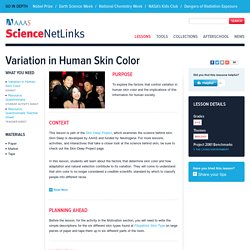

Literacy. Chapter 2 Section 3. Media Bias/Fact Check - Search and Learn the Bias of News Media.
Variation in Human Skin Color. Purpose To explore the factors that control variation in human skin color and the implications of this information for human society.

Context This lesson is part of the Skin Deep Project, which examines the science behind skin. Skin Deep is developed by AAAS and funded by Neutrogena. For more lessons, activities, and interactives that take a closer look at the science behind skin, be sure to check out the Skin Deep Project page. In this lesson, students will learn about the factors that determine skin color and how adaptation and natural selection contribute to its variation.
Diversity of human appearance and form has intrigued biologists for centuries, but nearly 100 years after the term “genetics” was coined by William Bateson in 1906, the genes that underlie this diversity are an unsolved mystery. Students at this grade level hold a number of misconceptions about topics related to skin color variation. Read More Planning Ahead Motivation How would you describe your skin type? Development. February 2021: Honoring Black Agency & Black Joy. This February, schools across the country recognize “Black History Month” with lessons, activities, and events meant to spotlight important figures in Black history and milestone events in the trajectory of Black life in America.

Here at Facing History, we know that Black history is central to all of American history, and should be part of a robust teaching curriculum year-round. Alongside the lessons of Black history, it’s also critical to honor the resilience, creativity, and vitality of Black people in the face of inequity and violence, past and present. That’s why, this year, we’re celebrating Black History Month by honoring the themes of Black Agency & Black Joy. Stay tuned this month as we share an array of teaching resources and blog posts designed to promote innovative instruction and reflection on these topics and help you strengthen your Black history curriculum for February and beyond.
Sign up to be notified when our new resources are available. Sway. Speech Structure Templates - Speech-Structure-Template.pdf. Python Tutorials, more than 300, updated March 2, 2009 and carefully sorted by topic and category. BeginnersGuide/NonProgrammers. Python for Non-Programmers If you've never programmed before, the tutorials on this page are recommended for you; they don't assume that you have previous experience.
If you have programming experience, also check out the BeginnersGuide/Programmers page. Books Each of these books can be purchased online but is also available as free textual, website, or video content. Automate the Boring Stuff with Python - Practical Programming for Total Beginners by Al Sweigart is "written for office workers, students, administrators, and anyone who uses a computer to learn how to code small, practical programs to automate tasks on their computer.
" You can find many free Python books online. Interactive Courses These sites give you instant feedback on programming problems that you can solve in your browser. CheckiO is a gamified website containing programming tasks that can be solved in Python 3. Resources for Younger Learners Tutorials and Websites Tutorial Aggregators / lists Apps Videos.
Media Bias/Fact Check - Search and Learn the Bias of News Media. He Said, She Said, and the Truth. But while balance may be necessary to mediating a dispute between teenage siblings, a different kind of balance — some call it “false equivalency” — has come under increasing fire. The firing squad is the public: readers and viewers who rely on accurate news reporting to make them informed citizens. Simply put, false balance is the journalistic practice of giving equal weight to both sides of a story, regardless of an established truth on one side. And many people are fed up with it. They don’t want to hear lies or half-truths given credence on one side, and shot down on the other. They want some real answers. “Recently, there’s been pressure to be more aggressive on fact-checking and truth-squading,” said Richard Stevenson, The Times’s political editor.
It’s all a part of a movement — brought about, in part, by a more demanding public, fueled by media critics, bloggers and denizens of the social media world — to present the truth, not just conflicting arguments leading to confusion. Mr. Principles of Journalism. The first three years of the Project’s work involved listening and talking with journalists and others around the country about what defines the work.

What emerged out of those conversations are the following nine core principles of journalism: 1. Journalism’s first obligation is to the truth Democracy depends on citizens having reliable, accurate facts put in a meaningful context. Journalism does not pursue truth in an absolute or philosophical sense, but it can–and must–pursue it in a practical sense. 2. While news organizations answer to many constituencies, including advertisers and shareholders, the journalists in those organizations must maintain allegiance to citizens and the larger public interest above any other if they are to provide the news without fear or favor. 3.
Journalists rely on a professional discipline for verifying information.